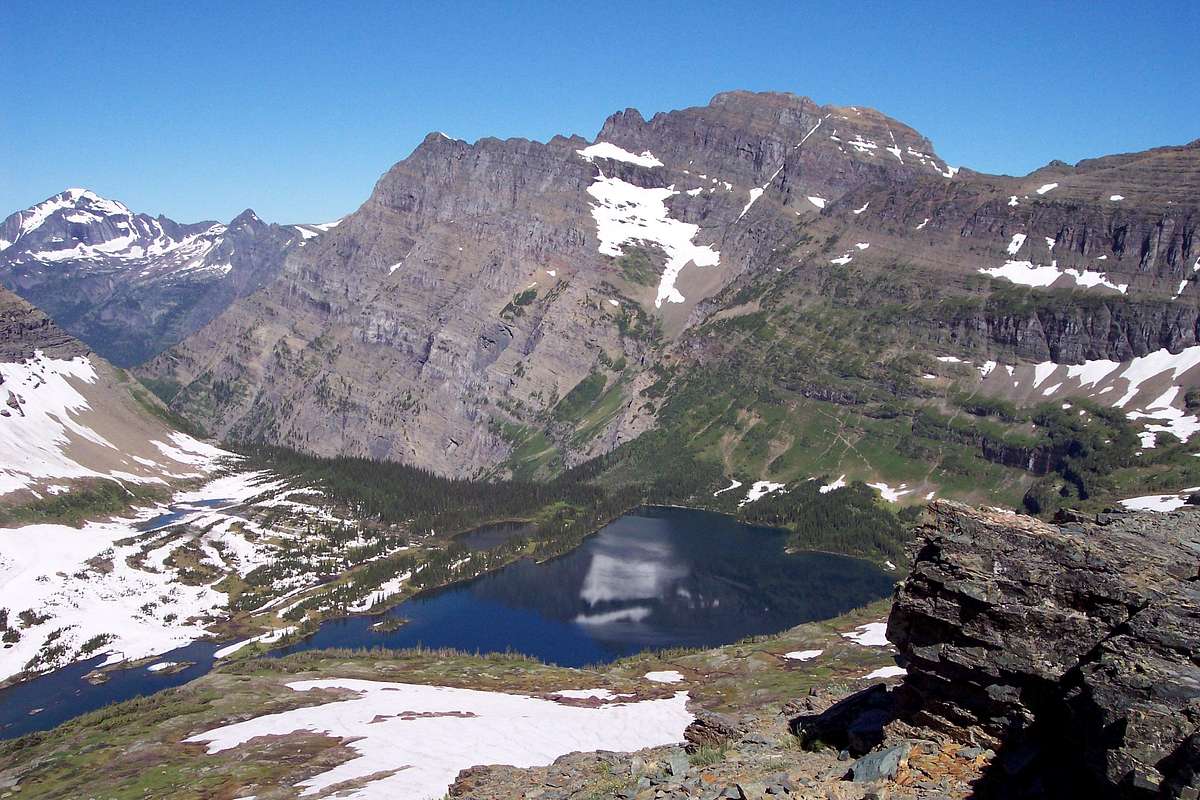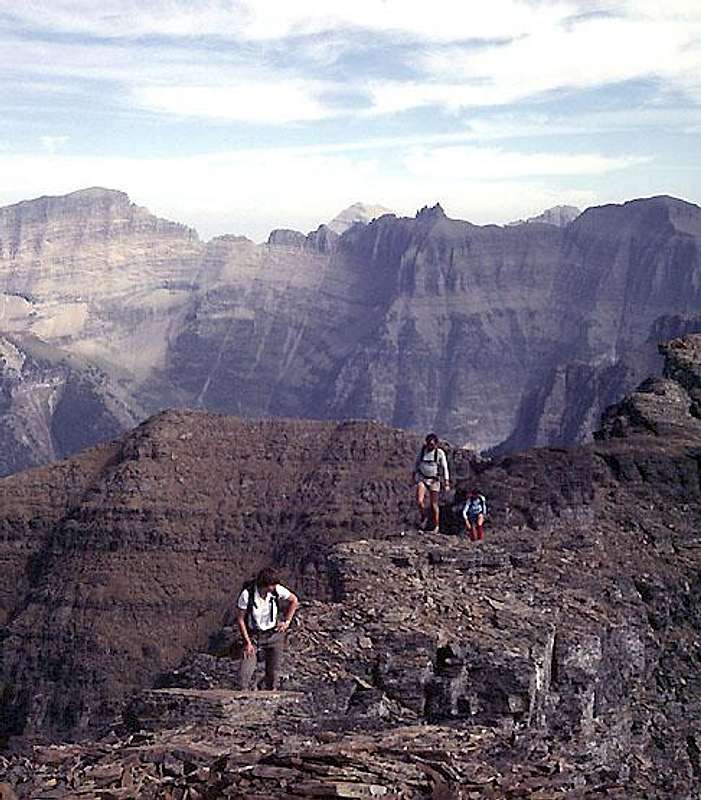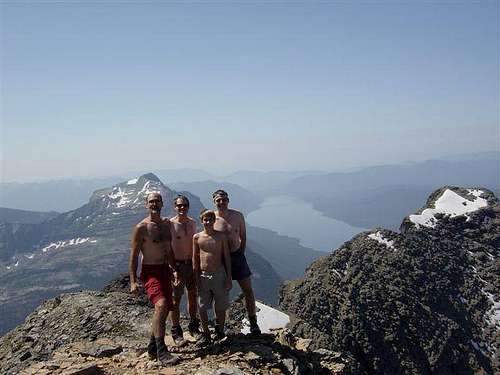-
 9212 Hits
9212 Hits
-
 79.76% Score
79.76% Score
-
 11 Votes
11 Votes
|
|
Route |
|---|---|
|
|
48.69230°N / 113.774°W |
|
|
Hiking, Mountaineering |
|
|
Spring, Summer, Fall |
|
|
Most of a day |
|
|
Class 4 |
|
|
Overview:
J. Gordon Edwards describes this route as about 5.5 miles and 2,200 vertical feet to the summit from Logan Pass. Incredible photographic opportunities abound around each bend on this climb.
Edwards describes part of the climb on page 282 of A Climber’s Guide To Glacier National Park as “climbing down a cliff for a few yards traversing above a frightening cliff, then working back up toward your left via a class 4 crack that is just south of the actual summit ridge.” The route described below avoids this class 4 exposure by purchasing the actual summit ridge before getting to the frightening cliff on Mount Cannon.
The Views:
A History Lesson on the Naming of Mount Cannon:
This 8,952 foot peak was originally named “Goat Mountain” by Dr. L. B. Sperry and was renamed Mount Cannon for Dr. Walter Bradford Cannon and his wife Cornelia James Cannon after they climbed to the summit of the southwest peak on July 19, 1901 while on their honeymoon. Accompanying them was Denis Comeau, a guide who Comeau Pass was named after.
Dr. Cannon was an experimental physiologist and has been called “the greatest American physiologist” by one of his colleagues.
He was the president of the American Psychological Association from 1914 to 1916. Dr. Cannon was influential in psychological research and coined the term “flight or flight” after studying animal’s responses to threats. That description is still used today in psychological circles.
He also worked at developing the concept of homeostasis and many of the hypotheses that he developed still are applicable today. During World War I, Dr. Cannon studied both hemorrhagic and traumatic shock and developed methods to store blood. He and a colleague also developed the Cannon-Baird Theory which helped to explain how the body changes by using both physiological and emotional responses to deal various situations.
It should be noted that contrary to J. Gordon Edwards’s comments about Dr. Cannon winning a Nobel Prize. However history indicates that he never received the award as mentioned in A Climber’s Guide To Glacier National Park.
His research did help contribute to a colleague, Otto Loewi, receiving the award in 1936.
Dr. Cannon's work was considered prize-worthy by many and contributed significantly to increasing understanding in physiology, psychology and neurology he never received the Nobel Prize accolade for his brilliant research.
Cornelia James Cannon was an author and her 1928 novel, Red Rust was a best seller. She was also a contributing writer to a number of monthly magazines. During that time she also raised 5 children.
East Ridge Approach:
Accessing the Climber’s Trail to Bird Woman Pass:
To access Bird Woman Pass follow the Hidden Lake Trail to the Hidden Lake Overview. Take time to view Hidden Lake as well as Bearhat with the rift extending up its east face. Observe the saddle where Clements on the immediate right meets Cannon which dominates the scene to the west. This pass is known as Bird Woman Pass and it is the first objective in this climb.
The route to the Climber’s Trail is found by continuing on the Hidden Lake Trail for another ½ mile. This spot is clearly distinguishable as it clearly is a trail that takes off to the right towards Bird Woman Pass.
The climber’s trail is not difficult to follow and is marked with cairns and there are sections where it might require using both hands to help negotiate the trail as it ascends through the brush and small cliffs. There should be nothing more extreme that class 2 on this approach to Bird Woman Pass if the correct route is followed.
Route Description:
Initial Portion of Climb:
From Bird Woman Pass follow the well marked climber's trail that is located along the north side of this ridge. You will quickly reach an area where the scree has ran out onto the northeast side of the ridge. The obvious climber's trail climbs up through this area.
Continue climbing up through a series of enjoyable scrambles through the prominent gully that the climber's trail passes through. There is a series of 3 to 4 short scrambles intermixed with scree chutes.
Accessing the Summit Ridge:
After climbing above the scree chutes it is easy to climb up to the right and achieve the east ridge. The well marked climber's follows the ridge until just below a ridge extending from the summit.
Edwards' route continues to the west just below that ridge and navigation of a Class 4 cliff must be completed. For those who choose this route there are good hand-holds and foot placement but just beyond the cliff there is significant risk of exposure when climbing up the gully to achieve the summit ridge.
I might suggest an alternate:
While hiking along the climber's trail below the summit ridge and just before the Class 4 cliff there is a wall that has two sections seperated by a ledge. The first portion of this wall is about 6 feet tall. After climbing this easy wall move along the ledge to the second section of wall that is about 8 feet high. There are adequate hand and foot holds here as well.
Above this wall it is a short and enjoyable scramble/walk to the actual summit.
Return to Bird Woman Pass:
Retrace your route to Bird Woman Pass then to the Hidden Trail being careful not to knock the loose scree down onto those below your descent route.
Essential Gear:
Hiking poles will aide in your ascent and descent while working through Glacier’s wonderful scree!This route is essentially dry so bring water as well.
This route is a little over a half a day long. Pack a lunch and enjoy the views at the top while eating lunch.
Of course you will also want your camera for the incredible 360 degree views.









